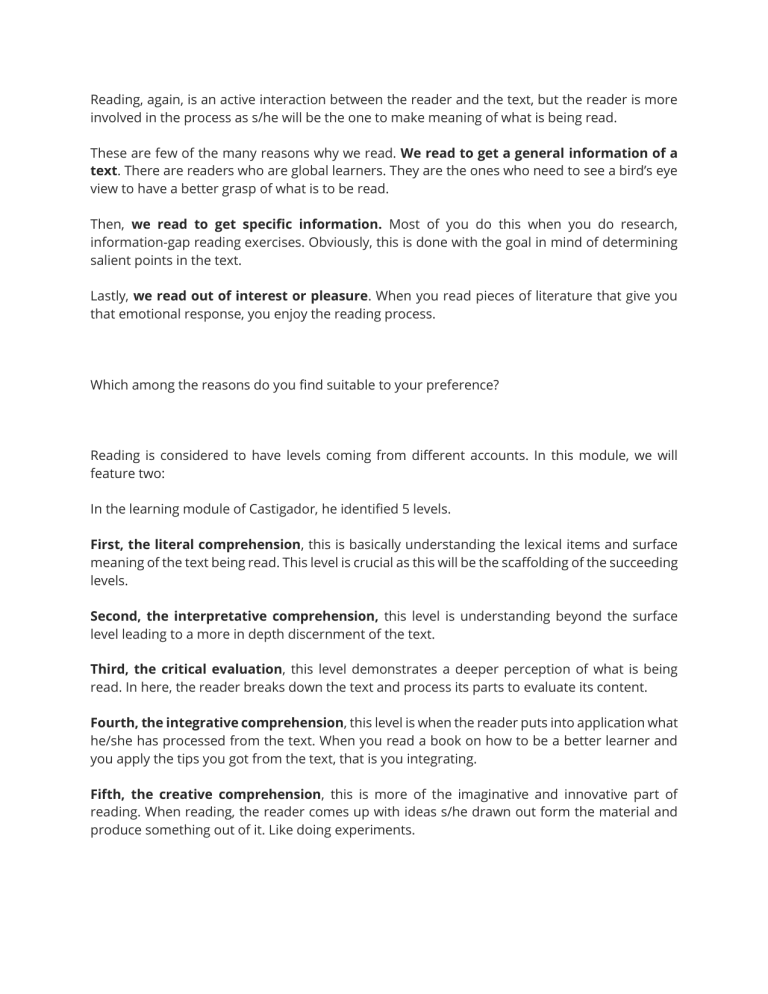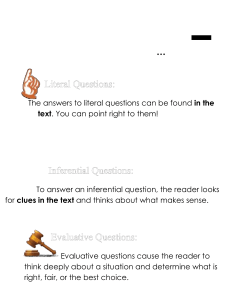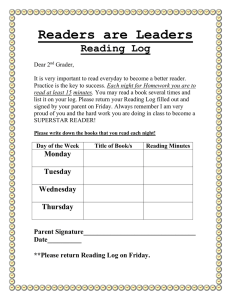
Reading, again, is an active interaction between the reader and the text, but the reader is more involved in the process as s/he will be the one to make meaning of what is being read. These are few of the many reasons why we read. We read to get a general information of a text. There are readers who are global learners. They are the ones who need to see a bird’s eye view to have a better grasp of what is to be read. Then, we read to get specific information. Most of you do this when you do research, information-gap reading exercises. Obviously, this is done with the goal in mind of determining salient points in the text. Lastly, we read out of interest or pleasure. When you read pieces of literature that give you that emotional response, you enjoy the reading process. Which among the reasons do you find suitable to your preference? Reading is considered to have levels coming from different accounts. In this module, we will feature two: In the learning module of Castigador, he identified 5 levels. First, the literal comprehension, this is basically understanding the lexical items and surface meaning of the text being read. This level is crucial as this will be the scaffolding of the succeeding levels. Second, the interpretative comprehension, this level is understanding beyond the surface level leading to a more in depth discernment of the text. Third, the critical evaluation, this level demonstrates a deeper perception of what is being read. In here, the reader breaks down the text and process its parts to evaluate its content. Fourth, the integrative comprehension, this level is when the reader puts into application what he/she has processed from the text. When you read a book on how to be a better learner and you apply the tips you got from the text, that is you integrating. Fifth, the creative comprehension, this is more of the imaginative and innovative part of reading. When reading, the reader comes up with ideas s/he drawn out form the material and produce something out of it. Like doing experiments. In relation to the levels of reading comprehension, Nuttall (2005) identifies five basic question types commonly used for reading. The first of these is literal comprehension. By this she means that if readers do not understand the literal meaning of a particular text, then they are probably not going to get very much else out of that text. The second is reorganizing or putting the information in the text into a different order. Then come questions of inferring or ‘reading between the lines’. Writers do not always state explicitly what they mean. An efficient reader can infer meaning not explicitly stated in the passage. This may be seen as an intellectual skill as opposed to a reading skill by some, although there is clearly a measure of overlap. Question types requiring a measure of personal response are often to be found in literary passages where the reader has to argue for a particular personal response supported by reference to the text. The last type of ques- tion is quite sophisticated and not all students would need it. Questions of evaluation would require the reader to assess how effectively the writer has conveyed her intention. If the writing is intended to convince or to persuade, how convincing or persuasive is it? In reading, the most important element is the text (written discourse). Text is immensely significant in all aspects of communication. Communication is characterized using sentences in connected stretches of language. Reading materials depict this very concept as written texts are manifestations of how language is patterned and most significantly, they are marked by coherence. Without this, reading would be a burden. In text, there are surface text and deep text Surface Text: explicit expression of knowledge Deep Text: occurs during processing, leaving knowledge implicit. Implicit messages are those that are not stated but are understood as they are implied in the message itself. Moreover, Connotation and Denotation are two principal methods of describing the meanings of words. Connotation refers to the wide array of positive and negative associations that most words naturally carry with them, whereas denotation is the precise, literal definition of a word that might be found in a dictionary. A part of Introduction to Communication Science dealt with levels of signification. The denotation which is the first order of signification, and connotation, the second order of signification. Simply, these levels were referred to non-verbal messages like when you see blue it is a color (denotation), but when connoted, it could represent something like peace, heavens. In relation to reading, we do the same thing When reading, explicit expression of thoughts in reading text may impact the reader that is why, at times, one must be politically correct to avoid offense, hurtful feeling, misunderstanding on the part of the reader. As readers, it is important to understand the power of double speaking since it can mitigate situations, where you can apply in your writing, or if used negatively, it can gain false trust. Doublespeak is language that deliberately obscures, disguises, distorts, or reverses the meaning of words. Doublespeak may take the form of euphemisms (e.g. "downsizing" for layoffs, "servicing the target" for bombing), in which case it is primarily meant to make the truth sound more palatable. It may also refer to intentional ambiguity in language or to actual inversions of meaning. In such cases, doublespeak disguises the nature of the truth. Doublespeak is most closely associated with political language. As readers, you must be keen on how the language is patterned and what messages are either explicitly or implicitly conveyed. Purposes of Doublespeak The purposes of doublespeak are varied. Since this is a human tactic, it's going to be complex and multi-faceted. That said, it's something to be avoided. Let's take a look at some of the root causes. To Be Politically Correct To Hide Negativity To Make Money To Perpetuate Lies Knowing the author’s purpose is like knowing what the main idea is and what the text is all about. In every text, the author serves a purpose in order to convey his/her ideas well. As an active reader, the person must identify the purpose to assist in the progress of reading. We have to persuade. These texts aims to be convincing by stating claims that could support the purpose and of course achieve its aim. The MAIN purpose is to convince the reader. Example A public service written announcement telling kids to stay in school. Persuasive writing aims to alter the reader’s mind or have perform an action. Then, we have to inform. This can be related to exposition. Explaining terms, theories, or in simpler terms providing information of a topic being discussed in written discourse. They provide claims of facts, The MAIN purpose is to enlighten the reader. Example A handbook teaching people how to negotiate. Informational writing may be entertaining, but the MAIN purpose is to inform. And, we have to entertain. This is when imagination and creativity take place. As reading materials that are intended to entertain and give value by having emotions or the affective domain as the target. The MAIN purpose is to amuse readers. Example A poem of a local pizzeria listing the sizes and prices of pizzas and available toppings. With this purpose, you may learn a thing or two from the author, but the ultimate goal is simply to entertain. Generally, what are claims? According to del Gandio (2008), a claim is an arguable statement that the writer wants the reader to accept. A claim is a statement. The writer has good knowledge of who the audience is. There is a wish for the audience to agree with the statement There is only anticipation though of an agreement because the idea of disagreement is still most likely to happen There is a worry that they might not agree As readers, understanding claims embedded in text would help in discerning the context of the written discourse. Also, it allows the reader to interpret the text using his/her knowledge of what the text aims to accomplish. Claim of fact This claim simply pertains to an information that can be proven by careful observation of time, a clear explanation is given that is factual, at times, what we think is true or false is a fact and provide reasons to this claim, and argument, usually, turns on strength of evidence as the reason of the arguer. Claim of value/judgment In claim of value, look for key words that are more judgement than facts: like amazing, beautiful, etc. Reasons are still provided, yet reasoning is not compared to facts This claim may be based on what is liked and disliked. In short, what is appealing. The argument turns on whether the underlying value of the claim is accepted as a public good. Claim of action/policy This focuses on calling out an action to be taken. Looking for key words like ought and should would help. They may not always appear, but these words show command or something has to be done. Reasons on what would happen upon performing the action are given as reasons. Arguments are presented as to explain how taking the action outweighs the costs of taking the action.





